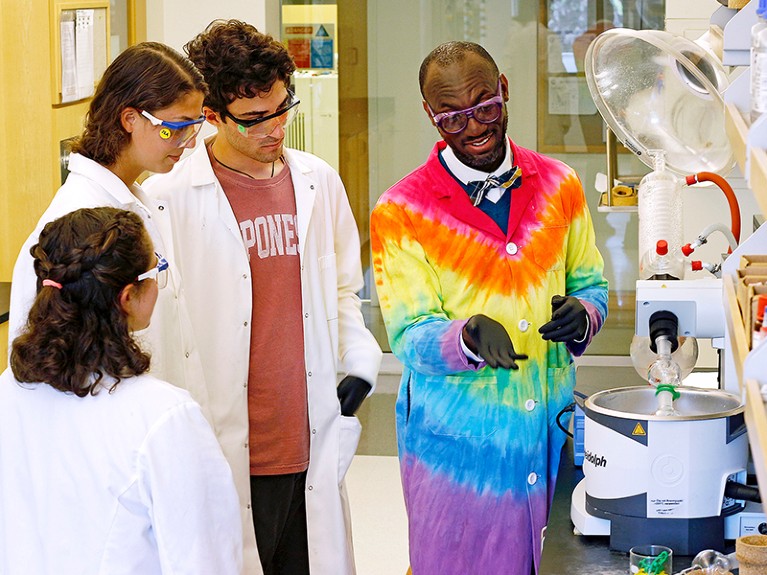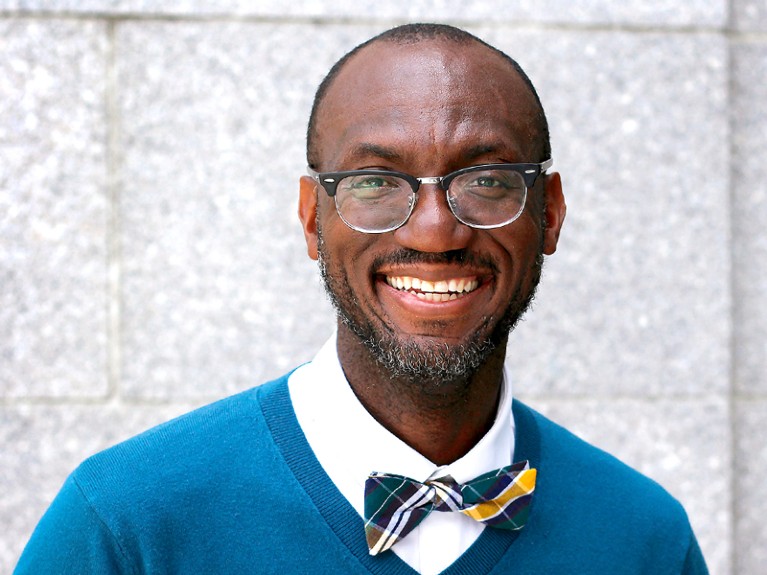
André Isaacs (right) with students in his laboratory, the site of many of his TikTok videos.Credit: John Buckingham
André Isaacs’ love of chemistry began at school in Kingston, Jamaica, inspired by his uncle — a teacher, who created fun ways to connect chemistry with life experiences. Isaacs earned his PhD from the University of Pennsylvania in Philadelphia in 2011 and did a postdoc at the University of California, Berkeley, before returning to the College of the Holy Cross in Worcester, Massachusetts — his undergraduate alma mater — as a group leader in organic chemistry in 2012. As an educator, he mixes his family’s values and culture of joy, community and cheering on others to create a unique chemistry with his students. He has made nearly 150 short videos on TikTok, Instagram and Twitter, showcasing himself and his students in performances such as recreating Rihanna’s 2023 Super Bowl dance moves in his lab (which grabbed the attention of the pop star’s choreographer) and celebrating the last class of the semester. With catchy songs and trendy dances, Isaacs spreads his love of his subject in striking costumes, encourages his students to succeed and urges other educators to build welcoming communities.
Some view social media as a distraction from teaching and research. Why do you invest time in it?
The usual image of a scientist is an old white guy, in a white lab coat, with no social skills. That’s an inaccurate picture. We have to break down those stereotypes. A lot of people belonging to minority sexual, racial and ethnic groups might not succeed in science, technology, engineering and maths (STEM) because the culture does not welcome them. In an era when science is under attack by politicians, we need people who can use social media to communicate it in an accessible way, including to people who aren’t researchers. We have to find creative ways to do that.
By being on social media and showcasing who I am — someone at the intersection of being Black, queer and an immigrant — I am showing that people with similar identities can be successful. It makes science exciting to younger people, who are running away from it in droves.
What led to the dance routines you create with your students?
I joined TikTok during the pandemic and started making fun videos, such as trying out cosplay from the film franchises Black Panther and Harry Potter to keep myself occupied. Once we were all back in the lab, my students found it cool and said we should do something together.
Most of the videos we do are trends, so the dances already exist. I’m usually the one tasked with adapting it to a chemistry theme. Some of my students have trained as dancers, so they deconstruct the dance from the videos, teach me the steps and we practise it to the music. Once we have it, I record it and do the editing. That’s one thing I’m better at than them! It’s a different way of building community.

André Isaacs built his chemistry classroom into a welcoming community of learners.Credit: John Buckingham
In other videos you do ‘exit interviews’ with your undergraduate students after exams. How do students respond?
It’s important to believe in your students. I have built this community where they’re comfortable sharing their honest thoughts. This is a different way of doing student evaluation — it’s live, in person and is how a lot of Gen Z students interact with social media. It’s helped me rethink some of the assumptions I once made about this generation, such as them being lazy. But I’ve learnt that they need to be motivated differently from how I was.
Surprisingly, the response has been very positive. Getting that reinforcement from students that my efforts were useful and productive was the most powerful thing that came out of it. For example, I required students to read about Alma Levant Hayden, an African American chemist working in the 1950s and 1960s. Many women shared how much it meant to them to read about her, and the African American students commented on how powerful it was to learn about a successful Black woman in STEM.
What have you learnt as an educator by putting yourself out there with students on social media?
It’s fascinating because in that moment, I’m empowering my students to teach me. As an educator — often in a position of power — I am taking a step back and flipping the script. I’m relinquishing this image of a perfect person who knows everything. It’s helped me to realize that I, too, need time to learn different things.
I’ve caught some of their vocabulary — words like ‘med’ (short for mediocre) and ‘slay’ (doing something well). I’ve also learnt about their philosophy. This generation doesn’t have a lot of faith in what the world has to offer them because they’ve grown up moving from challenge to challenge. I get to try to inspire them to believe that they can change the world for the better. It’s also helped me think about what matters to students and what aspects they struggle with.
In my teaching, it’s forced me to make connections to real-world experiences more than ever. When I teach about cis– and trans-alkenes — in which cis and trans describe the positions of two chemical groups across a plane in a molecule — that’s my opportunity to mention the connection between cis- and transgender identities. I’ve learnt to make my course into a safe space and I use course materials that are welcoming and inclusive of different cultures. I think this helps students to feel better about their place in the world.
Have you had to deal with social-media trolls?
Yes. I anticipated pushback, particularly as a Black, immigrant, queer man. That’s the thing about social media — you have to weigh up the pros and the cons. I am doing this to inspire the younger generation and so it’s worth it. To the trolls, I say: bring it on, it doesn’t matter to me, I’m going to keep doing the work I do!
What advice do you have for other educators about building communities and safe spaces with students?
Be your quirky, awkward self. Your students will gravitate towards authentic people who care deeply about their success.
The scientific community’s efforts around improving retention of people from minority racial, ethnic, sexual and gender groups have not worked so far. Creating an environment that is culturally responsive to students could go a long way towards improving that. All the work that I do is an effort to address that sense of belonging. Education is not just about disseminating knowledge. Students learn better when they are part of a community that values them.
This interview has been edited for length and clarity.

